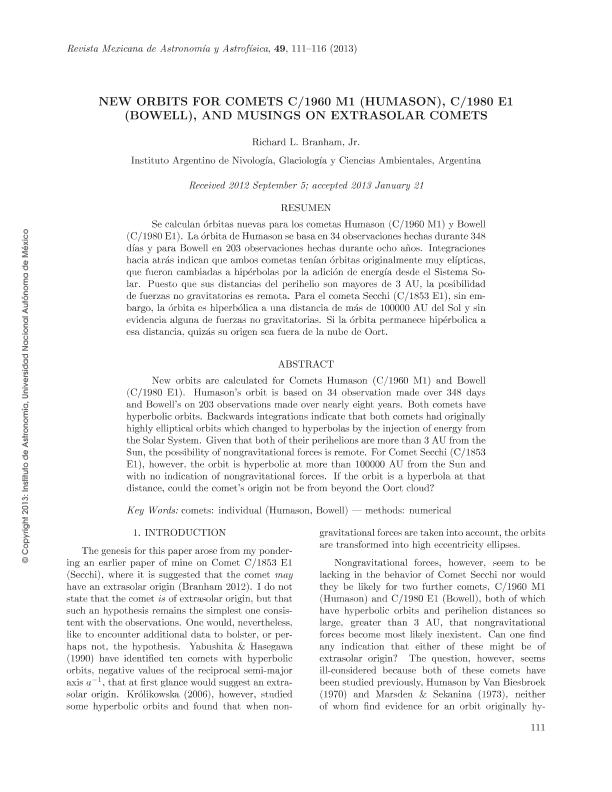Artículo
Se calculan órbitas nuevas para los Cometas Humasen (C/1960 M1) y Bowell (C/1980 E1). La órbita de Humasen se basa en 34 observaciones hechas durante 348 dias y para Bowell 203 observaciones hechas durante ocho años. Integraciones hacia atras indican que ambos cometas tenían orbitas originalmente muy elípticas cambiadas a hipérbolas por la adición de energía desde el sistema solar. Puesto que sus distancias del perihelio son mayores de 3 AU, la posibilidad de fuerzas no gravitatorias es remota. Para el Cometa Secchi (C/1853 E1), sin embargo, la orbita es hiperbolica a una distancia de mass de 100.000 AU del sol y con ninguna evidencia de fuerzas no gravitatorias. Si la orbita queda una hipérbola a esa distancia, quizás su origen sea fuera de la nube de Oort. New orbits are calculated for Comets Humasen (C/1960 M1) and Bowell (C/1980 E1). Humasen’s orbit is based on 34 observation made over 348 days and Bowell’s on 203 observations made over nearly eight years. Both comets have hyperbolic orbits. Backwards integrations indicate that both comets had originally highly elliptical orbits changed to hyperbolas by the injection of energy from the solar system. Given that both of their perihelions are more than 3 AU from the sun, the possibility of nongravitational forces is remote. For Comet Secchi (C/1853 E1), however, the orbit is hyperbolic at more than 100,000 AU from the sun and with no indication of nongravitational forces. If the orbit is a hyperbola at that distance, could the comet’s origin not be from beyond the Oort cloud?
New orbits for Comets C/1960 M1 (Humason), C/1980 E1 (Bowell), and musings on extrasolar comets
Fecha de publicación:
04/2013
Editorial:
Universidad Nacional Autónoma de México. Instituto de Astronomía
Revista:
Revista Mexicana de Astronomía y Astrofísica
ISSN:
0185-1101
Idioma:
Inglés
Tipo de recurso:
Artículo publicado
Clasificación temática:
Resumen
Palabras clave:
Comets: Individual (Humason, Bowell)
,
Methods: Numerical
Archivos asociados
Licencia
Identificadores
Colecciones
Articulos(IANIGLA)
Articulos de INST. ARG. DE NIVOLOGIA, GLACIOLOGIA Y CS. AMBIENT
Articulos de INST. ARG. DE NIVOLOGIA, GLACIOLOGIA Y CS. AMBIENT
Citación
Branham, Richard Lacy; New orbits for Comets C/1960 M1 (Humason), C/1980 E1 (Bowell), and musings on extrasolar comets; Universidad Nacional Autónoma de México. Instituto de Astronomía; Revista Mexicana de Astronomía y Astrofísica; 49; 1; 4-2013; 111-116
Compartir




